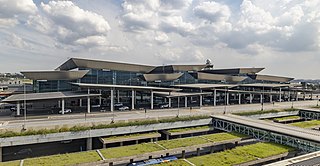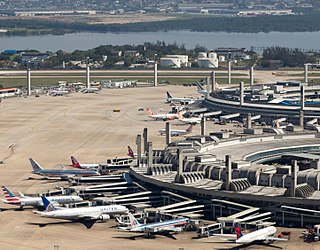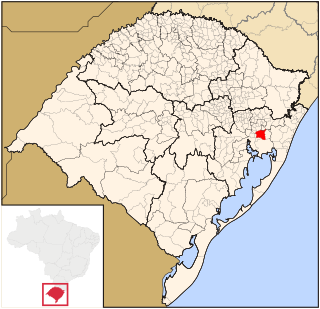
Brasília is the federal capital of Brazil and seat of government of the Federal District, located in the Brazilian highlands in the country's Central-West region. It was founded by President Juscelino Kubitschek on 21 April 1960, to replace Rio de Janeiro as the national capital. Brasília is Brazil's third-most populous city after São Paulo and Rio de Janeiro. Among major Latin American cities, it has the highest GDP per capita.

Rio de Janeiro, or simply Rio, is the capital of the state of Rio de Janeiro. It is the second-most-populous city in Brazil and the sixth-most-populous city in the Americas.

São Paulo/Guarulhos–Governor André Franco Montoro International Airport, commonly known as São Paulo/Guarulhos International Airport, is the primary international airport serving São Paulo. It is popularly known locally as either Cumbica Airport, after the district where it is located and the Brazilian Air Force base that exists at the airport complex, or Guarulhos Airport, after the municipality of Guarulhos, in the state of São Paulo, where it is located. Since November 28, 2001, the airport has been named after André Franco Montoro (1916–1999), former Governor of São Paulo state. The airport was rebranded as GRU Airport in 2012.

Empresa Brasileira de Infraestrutura Aeroportuária is a Brazilian government corporation founded in 1973, authorized by Law 5,862, that is responsible for operating the main Brazilian commercial airports. In 2011 Infraero's airports carried 179,482,228 passengers, 1,464,484 tons of cargo, and operated 2,893,631 take-offs and landings. Presently it manages 45 airports.

Rio de Janeiro/Galeão–Antonio Carlos Jobim International Airport, popularly known by its original name Galeão International Airport, is the main international airport serving Rio de Janeiro, Brazil.

Santos Dumont Airport is the second major airport serving Rio de Janeiro, Brazil. It is named after the Brazilian aviation pioneer Alberto Santos Dumont (1873–1932).

The Rio de Janeiro Metro, commonly referred to as just the Metrô is a rapid transit network that serves the city of Rio de Janeiro, Brazil. The Metrô was inaugurated on 5 March 1979, and consisted of five stations operating on a single line. The system currently covers a total of 58 kilometres (36 mi), serving 41 stations, divided into three lines: Line 1 ; Line 2, which together travel over a shared stretch of line that covers 10 stations of an approximate distance of 5 kilometres (3.1 mi); and Line 4. Metrô Rio has the second highest passenger volume of the metro systems in Brazil, after the São Paulo Metro.

Gravataí is a Brazilian municipality near Porto Alegre at the Rio Grande do Sul State. Its population is approximately 280,000 people, making it the sixth most populous city in the state.

Complexo do Alemão is a group of favelas in the North Zone of Rio de Janeiro, Brazil.

SuperVia Trens Urbanos is a rapid transit and commuter rail company operator, founded in Rio de Janeiro (Brazil) in November 1998. It carries around 750,000 passengers a day on a railroad network comprising 104 stations in 12 cities: Rio de Janeiro, Duque de Caxias, Guapimirim, Nova Iguaçu, Nilópolis, Mesquita, Queimados, São João de Meriti, Belford Roxo, Japeri, Paracambi and Magé.

General Osório / Ipanema is a station on Line 1 of the Rio de Janeiro Metro located in the Ipanema borough of Rio de Janeiro, Brazil. It is the line's southern terminus. The station opened in December 2009.

Méier is a middle class and upper middle class neighborhood in the North Zone of Rio de Janeiro, Brazil. The neighborhood is the historic center of the "Área dos Engenhos", or "Mill Area", which today is known as Grande Méier and has been a sub-prefecture since 2013. As a result, it has a wide range of shops and a variety of services and transport, although it is not one of the largest neighborhoods of the municipality. In the neighborhood is located one of the first shopping centers in Brazil, Shopping do Méier, opened in 1963. It has two distinct urban appearances, one more bustling, commercial, in the areas close to the train station, and a quieter one, on more residential streets.
Dalal Achcar is a Brazilian ballet master, choreographer, artistic director and producer.

Vicente de Carvalho Station is an integrated Rio de Janeiro Metro subway and BRT bus station that services the neighbourhood of Vicente de Carvalho in the North Zone of Rio de Janeiro.

Novo Rio Bus Terminal is the main bus station in Rio de Janeiro, Rio de Janeiro State, Brazil. The terminal was constructed in 1965 and was built for the proximity to Centro and key routes in and out of Rio de Janeiro.

Praça XV Station is a ferry terminal in Rio de Janeiro, Brazil. The terminal is located on the Praça XV de Novembro and is operated by CCR Barcas.

Jardim Oceânico / Barra da Tijuca is a station on the Rio de Janeiro Metro that services the neighborhood of Barra da Tijuca in the West Zone of Rio de Janeiro. It was previously simply named Jardim Oceânico, but was renamed alongside many others in August 2022 to include its neighborhood, Barra da Tijuca, in the name.

Anna Maria Baldo Niemeyer was a Brazilian architect, furniture designer and gallery owner. The only child of Oscar Niemeyer, she worked with her father to design the civic buildings for Brasília, focusing primarily on interior spaces and decoration. When her father decided to make furniture to harmonize his structures with the design elements, she turned her interest to furniture designing. Her two most noted designs were the initial prototype called the "Alta" and the "Rio". In her later career, she ran an art gallery in Rio, which at one time was the only gallery in the city, and assisted in the creation of the Niterói Contemporary Art Museum.

The Rio de Janeiro bus system forms an important part of the public transport system in the city of Rio de Janeiro in Brazil.



















